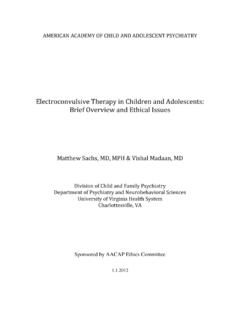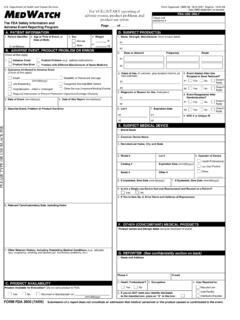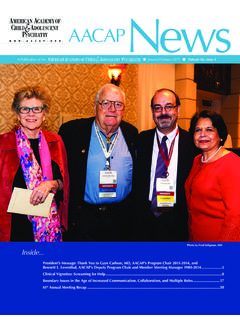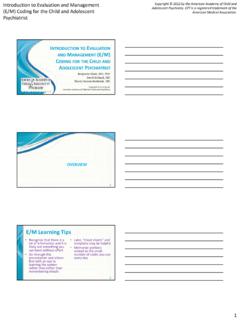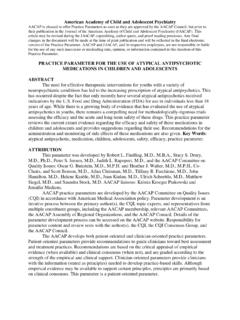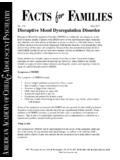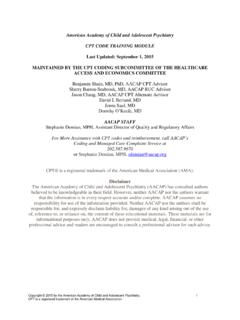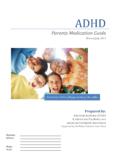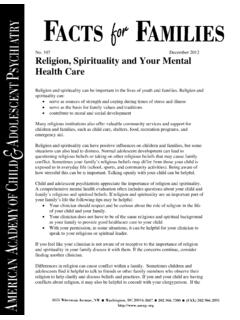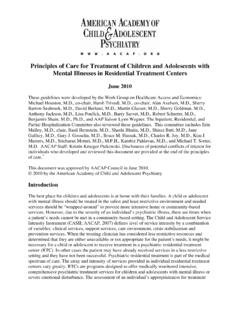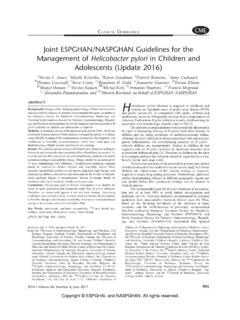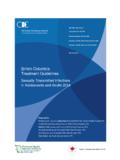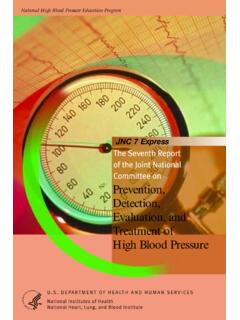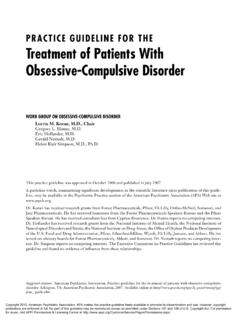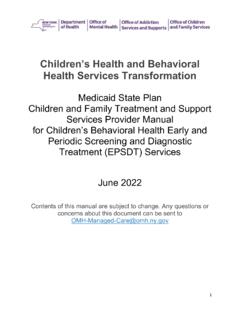Transcription of Practice Parameters for the Psychiatric Assessment of ...
1 AMERICAN ACADEMY OF CHILD AND adolescent PSYCHIATRY Practice Parameters for the Psychiatric Assessment of children and Adolescents These Parameters were developed by Robert A. King, principal author, the Work Group on Quality Issues: William A. Ayres, , Chair; Members: Elissa Benedek, , Gail A. Bernstein, , Etta Bryant, , Richard L. Gross, , Robert King, , Henrietta Leonard, , William Licamele, , Jon McClellan, , and Kailie Shaw, Consultants: William Bernet, , Stephen Herman, , Mary Schwab-Stone, , Elizabeth Weller, , and Deborah Zarin, The experts who commented on this draft were David Berland, , Ian A.
2 Canino, , Donald J. Carek, , Manuel L. Cepeda, , Lee Combrinck-Graham, , Carlo P. DeAntonio, , Martin Drell, , Mina K. Dulcan, , Charles Hart Enzer, , Judy Garber, , James E. Joy, , Paul Kay, , Clarice Kestenbaum, , Wun Jung Kim, , Kevin Leehey, , Anna E. Muelling, , Barry Nurcombe, , Robert Racusin, , Rachel Ritvo, , Maurice Rosenthal, , Edward Sperling, , Frederick Stoddard, , D. Clifton Wilkerson, and Diane H. Wolfe, (AACAP Staff: Mary Graham, Leslie Seigle, Carolyn Heier, and Amy Sonne.) A draft of these Parameters was distributed to the entire AACAP membership for comments.
3 The Parameters were approved by the AACAP Council on March 13, 1995. Developed with partial funding from the Center for Mental Health Services, Substance Abuse and Mental Health Services Administration. Reprint requests to AACAP Publications Department, 3615 Wisconsin Ave., , Washington, DC 20016. 1995 by the American Academy of Child and adolescent Psychiatry. ABSTRACT These Practice Parameters were developed by the American Academy of Child and adolescent Psychiatry as a guide for clinicians evaluatiing Psychiatric disorders in children and adolescents. The document focuses on the Assessment , diagnostic, and treatment planning process, emphassizing a developmental perspective.
4 The Assessment process is intended for all children and adolescents presenting with Psychiatric disorders that impair emotional, cognotive, physical, or behvioral functioning to assist the clinician in arriving at accurate diagnoses and in appropriate treatments. Details of the parent and child interviews are presented as well as an outline of specific areas of inquiry necessary for this process. The use of standardized tests and rating scales is addressed. These Parameters were previously published in Child Adolesc. Psychiatry, 1995, 31:1386-1402. Acad. Cchild Adolesc. Psychiatry, 1997, 36(10 Supplement):4S-20S.
5 Key words: Psychiatric Assessment , Psychiatric diagnoses, child and adolescent psychiatry, Practice Parameters , guidelines . 1995 1 NOT FOR DISTRIBUTION OR CITATION AMERICAN ACADEMY OF CHILD AND adolescent PSYCHIATRY Child and adolescent psychiatrists evaluate and treat children and adolescents who have Psychiatric disorders that impair emotional, cognitive, physical, and/or behavioral functioning. The child or adolescent is evaluated in the context of the family, school, community, and culture. Most of the identified signs and symptoms with their associated impairments in developmental functioning respond to established treatments.
6 The physician must prioritize symptoms and diagnoses so that a reasonable treatment plan will address multiple problems. Many children and adolescents have comorbid disorders which do not fit into a single DSM category. The physician in an individual situation should consider but not be limited to the treatment guidelines for a single diagnosis. Practice Parameters provide guidelines for patterns of Practice , not for the care of a particular individual. This report is not intended to be construed or to serve as a standard of medical care. Standards of medical care are determined on all the facts and circumstances involved in an individual case and are subject to change as scientific knowledge and technology advance.
7 The Parameters of Practice should not be construed as including all proper methods of care or excluding other acceptable methods of care reasonably directed to obtain the same results. Adherence to these Parameters will not ensure a successful outcome in every case. The ultimate judgment regarding any specific clinical procedure or treatment must be made by the physician in light of all the circumstances presented by the patient and family and the resources available. These Parameters of Practice were approved as of the date indicated, and they should not be applied to clinical situations occurring before that date.
8 In this guideline, the term child refers to both adolescents and younger children unless explicitly noted; unless otherwise noted, parents refers to the child's primary caretakers, regardless of whether they are the biological or adoptive parents or legal guardians. These guidelines are applicable to the evaluation of child and adolescent patients 18 years of age and younger. This document presumes familiarity with normal child development and the principles of child Psychiatric diagnosis and treatment (see standard textbooks by Kestenbaum and Williams, 1988; King and Noshpitz, 1991; Lewis, 1991a; Rutter and Hersov, 1994; Shaffer et al.)
9 , 1985; Wiener, 1991). The purposes of the diagnostic Assessment of the child are (1) to determine whether psychopathology is present and, if so, to establish a differential diagnosis; (2) to determine whether treatment is indicated; and, (3) if so, to develop treatment recommendations and plans and to facilitate the family and child's cooperative engagement in treatment . (For specialized consultative purposes or under emergency circumstances, the focus of inquiry may be narrowed accordingly. Examples of such focal evaluations may include medication consultations, emergency evaluations, or the determination of dangerousness to self or others for the purpose of hospitalization.
10 In these and other circumstances, therapeutic interventions may need to be implemented promptly, with fuller Assessment later, during the course of treatment .) The specific aims of the diagnostic Assessment of the child are (1) to identify the stated reasons and factors leading to referral; (2) to obtain an accurate picture of the child's developmental functioning and of the nature and extent of the child's behavioral difficulties, functional impairment, and/or subjective distress; and (3) to identify potential individual, family, or environmental factors that may account for, influence, or ameliorate these difficulties.
